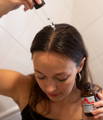If the part in your hair is widening, you find bald spots, or you notice excessive daily hair shedding for longer than 3 months, see a dermatologist or trichologist to rule out underlying factors that need to be addressed. To determine the cause of your hair loss, your doctor will examine your scalp to check for inflammation, redness, sores, or scarring. They’ll look closely at your hair to determine how much is being lost, the pattern of the hair loss, and whether there is hair breakage. Your doctor will also ask questions about when the hair loss began, what the patterns of hair loss are, what kind of hairstyles you usually wear, whether hair loss runs in your family, and other details about your symptoms to determine the best course of action for your treatment plan.













Leave a comment
Comments will be approved before showing up.